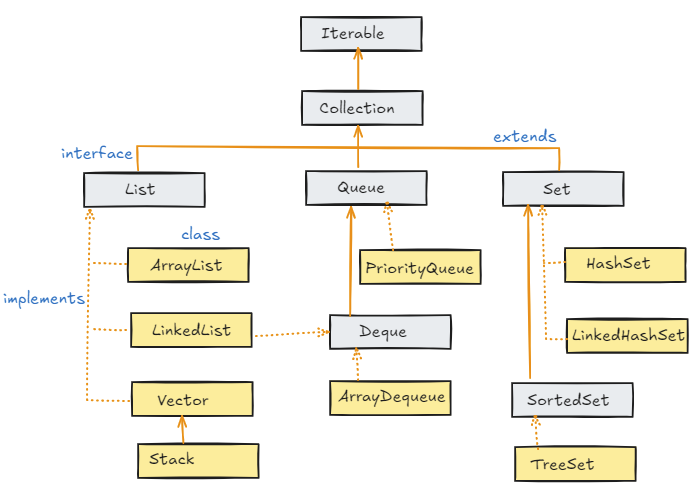Set Interface
The Set

Hashset
- Uses a hash table for storage
- Contains unique elements
- Doesnt maintain insertion order
HashSet<Integer> set=new HashSet();
set.add(1);
set.add(2);
set.add(3);
set.remove(1);
set.addAll(set1); // set1 is another HashSet
set.removeAll(set1);
set.clear();
// Another collection to Hashset
ArrayList<Integer> list=new ArrayList<Integer>();
HashSet<Integer> set=new HashSet(list);
//Printing
Iterator<Integer> itr=set.iterator();
while(itr.hasNext()){
System.out.println(itr.next());
}
LinkedHashSet
- Maintains Insertion Order
- Extends
HashSetbut is slightly slower due to ordering overhead.
LinkedHashSet<String> linkedSet = new LinkedHashSet<>();
linkedSet.add("A");
linkedSet.add("B");
linkedSet.add("C");
System.out.println(linkedSet); // Output: [A, B, C]
TreeSet
- It implements
NavigableSetand extendsSortedSet - Basically an implementation of self-balancing tree
- Doesnt allow null elements
- Maintains Ascending order
TreeSet<String> t = new TreeSet<>();
t.add(4);
t.add(1);
Iterator i = t.descendingIterator(); // to traverse in desceding order
while(i.hasNext()) System.out.println(i.next());
t.pollFirst(); // returns & removes first(lowest) in TreeSet
t.pollLast();
t.descendingSet(); // Reverse Treeset
t.first(); //returns first value
t.last();
t.contains(1);
t.headSet(3); // element less than 3 will be returned
t.tailSet(3); // elements>3 returned
t.remove(1);
t.subset(1,5); // elements between 1(inclusive) and 5(exclusive) returned
t.size();
t.lower(3); // returns greatest element in set which is less than 3
t.higher(3); // returns smallest element in set which is greater than 3